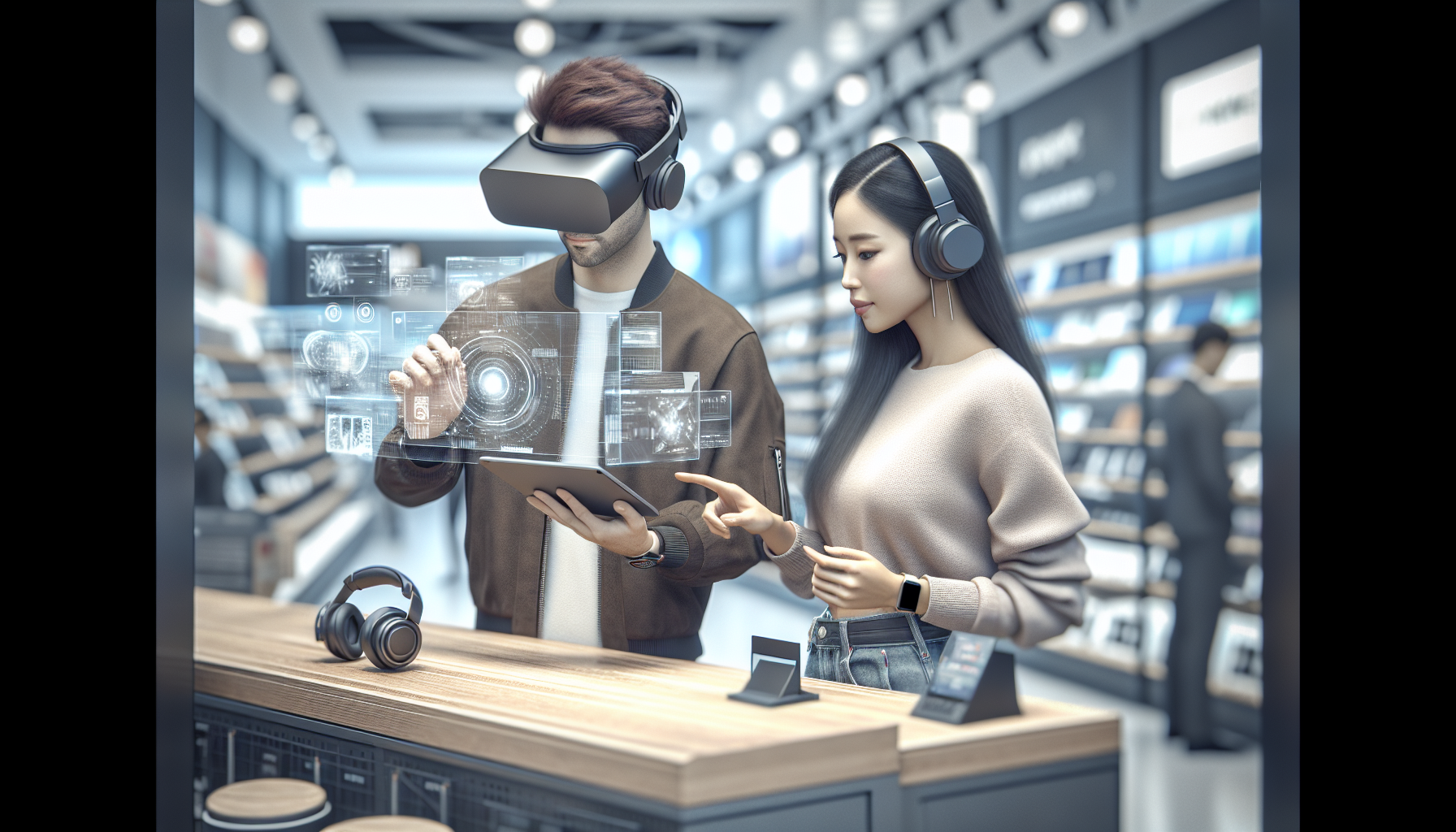Table of Contents
Understanding Augmented Reality (AR)

Key Points
- Enhanced Engagement: AR advertising significantly increases consumer engagement by providing immersive and interactive experiences.
- Improved Recall: Studies show that AR experiences, due to their interactive nature, lead to better recall of product features and brand messages.
- Personalization: AR allows for personalized marketing experiences, tailoring content to individual consumer preferences and behaviors.
- Increased Conversion Rates: Businesses using AR have reported higher conversion rates as consumers can visualize products in their own environment before purchasing.
- Future Growth: The AR market is expected to expand substantially, with increasing adoption across various industries enhancing consumer shopping experiences.
Technical Overview
Augmented Reality (AR) overlays digital information onto the real world, enhancing the user’s perception and interaction with their environment. This technology utilizes devices such as smartphones, tablets, and AR glasses to merge virtual content with physical surroundings, providing a composite view that can be both informative and engaging. AR operates through a combination of cameras, sensors, and advanced software algorithms that process the user’s environment and overlay relevant digital data in real-time. This integration of virtual and real elements creates a seamless user experience that can be leveraged for various applications, particularly in marketing and consumer behavior. The effectiveness of AR in advertising stems from its ability to create memorable, engaging experiences that resonate with consumers. By enabling users to interact with products virtually, AR helps reduce the uncertainty associated with online shopping, thereby positively influencing purchase decisions. Moreover, AR’s capability to provide detailed product previews and simulations fosters a deeper connection between the consumer and the product, potentially leading to increased customer satisfaction and loyalty.Current Applications in Consumer Markets
AR technology has been successfully implemented across multiple consumer-facing industries to enhance the shopping experience. In retail, AR enables customers to visualize furniture and decor in their own homes before making a purchase. Fashion and beauty brands offer virtual try-ons, allowing consumers to see how a particular makeup look or clothing item would appear on them. In the automotive industry, AR is used to provide potential buyers with a virtual tour of a car, including an interactive exploration of its features and capabilities. Real estate companies use AR to offer virtual property tours, helping clients make informed decisions without physical site visits. These applications not only enhance customer engagement but also provide businesses with valuable insights into consumer preferences and behavior, enabling more targeted and effective marketing strategies.Challenges in AR Adoption for Marketing

Technical Limitations and Consumer Accessibility
Despite its potential, the widespread adoption of AR in consumer decision-making faces several challenges. Technical limitations, such as the need for high processing power and advanced graphics capabilities, can restrict the functionality and accessibility of AR applications. Additionally, the requirement for consumers to possess AR-enabled devices or download specific apps can limit the reach of AR marketing campaigns. These technical barriers not only hinder the user experience but also pose significant development and maintenance costs for businesses. Ensuring smooth and effective AR experiences requires continuous updates and optimization, which can be resource-intensive.Privacy Concerns and Data Security
Another significant challenge is the concern over consumer privacy and data security. AR applications often require access to personal data, such as location and visual information, raising issues regarding data handling and user consent. Businesses must navigate these concerns carefully to maintain consumer trust and comply with regulatory requirements. Moreover, AR’s immersive nature can lead to an overreliance on virtual information, potentially skewing consumer perceptions and leading to decision-making biases. It is crucial for businesses to ensure that AR content is accurate, relevant, and enhances rather than detracts from the reality of the products or services being offered.Strategies for Effective AR Marketing

Step 1: Define Clear Objectives
For businesses looking to leverage AR to enhance consumer purchase decisions, the first step is to clearly define the marketing objectives. Whether the goal is to increase brand awareness, improve customer engagement, or drive sales, having a clear understanding of the desired outcomes is crucial for developing an effective AR strategy.Step 2: Develop Engaging Content
The success of an AR marketing campaign largely depends on the quality and relevance of the content. Businesses should focus on creating engaging, interactive AR experiences that add value to the consumer’s shopping journey. This could include virtual product demonstrations, interactive ads, or personalized product recommendations based on the user’s environment and preferences.Step 3: Ensure Accessibility and Ease of Use
To maximize the impact of AR marketing, it is essential to ensure that the AR experiences are accessible and easy to use. This includes optimizing the AR content for different devices and platforms, reducing the need for additional downloads or equipment, and providing clear instructions for first-time users.Step 4: Measure and Optimize
Continuously measuring the effectiveness of AR campaigns and making data-driven optimizations is key to long-term success. Businesses should implement robust analytics to track user engagement, conversion rates, and other relevant metrics. This data can then be used to refine the AR content and strategy, ensuring that it remains aligned with consumer preferences and business objectives.FAQs

What is Augmented Reality?
Augmented Reality (AR) is a technology that overlays digital information in the real world, enhancing the user’s perception and interaction with their environment. It uses devices like smartphones and AR glasses to merge virtual content with physical surroundings.How does AR influence consumer behavior?
AR influences consumer behavior by providing immersive and interactive experiences that enhance engagement and recall. It allows consumers to visualize products in their own environment, leading to more informed and confident purchase decisions.What are the challenges of using AR in marketing?
The main challenges include technical limitations, such as the need for advanced graphics and processing capabilities and consumer privacy concerns related to data security and personal information handling.Can AR improve online shopping experiences?
Yes, AR can significantly improve online shopping experiences by allowing consumers to try products virtually, reducing uncertainty, and providing a more interactive and personalized shopping journey.Looking Ahead: The Future of AR in Consumer Decisions
 As AR technology continues to evolve, its impact on consumer purchase decisions is expected to grow significantly. Here are five predictions for the future of AR in marketing:
As AR technology continues to evolve, its impact on consumer purchase decisions is expected to grow significantly. Here are five predictions for the future of AR in marketing:- Widespread Adoption: AR will become a standard feature in online and offline shopping, providing consumers with immersive experiences across various industries.
- Enhanced Personalization: AR will offer even more personalized shopping experiences, using AI to analyze consumer behavior and preferences to tailor content dynamically.
- Integration with AI: The integration of AR with AI technologies will lead to smarter, context-aware marketing that anticipates consumer needs and preferences.
- Improvement in Technology: Advances in AR hardware and software will reduce current technical limitations, making AR more accessible and effective for a broader audience.
- Regulatory Developments: As AR becomes more prevalent, regulatory frameworks will evolve to address privacy and data security concerns and ensure consumer protection.
References
- Research on AR’s Impact on Consumer Behavior – A comprehensive study comparing traditional and immersive marketing approaches.
- Frontiers in Virtual Reality – An article discussing consumer behavior in augmented shopping reality.
- ScienceDirect – Research on consumer interactions with AR in retail settings.
- Marketing Letters – A study on the effects of AR versus traditional advertising.
- BCG Publication on AR in Advertising – Insights into how AR is transforming the advertising industry.
Disclaimer
This article is AI-generated for educational purposes and does not intend to give advice or recommend its implementation. It aims to inspire readers to research and delve deeper into the topics covered.Latest posts by Leo Celis (see all)
- From SaaS to AI Agents - 05/27/25
- The AI Automation Engineer - 05/13/25
- Hire One Developer to Press One Key - 05/06/25